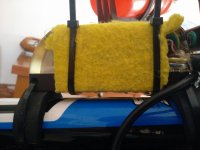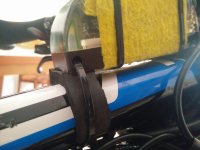I finally came up with a brillinat yet simple coolding method.
It involves cooling the PR (Phaserunner) using simple water evaporative cooling, by using wrapped wet cloth. You can see some pictures at the bottom of this message.
First, the PR is not directly secured to the top-tube but has about 1cm gap, supported by two thick rubbers, so there is a an air flow also on the most important part - the built in metal heat-sink.
I use 2 cable ties to fasten and secure the cloth (regular cleaning cloth cut to size) so that it overlaps fully and tightly streched so it has the best contact with the heatsink and the rest of the body.
I tested this on a bike with the fast-wind GrinHub (6T).
If you rely mostly on the motor power to ascend uphils, then that hub needs 96A quite often, and I found that with the regular air cooling the hub and the PR would reach the thermal rollback around the same time.
Now, there is absolutely no rollback at all and the PR keeps giving those max 96A. (Now only the motor is the temperature rollback bottleneck)
I know it delivers 96A continuously not just from the torque sensation but also because it started to melt the stock 3-andersons, and so I replaced those with the XT60 connectors.
This is so simple, yet light and brilliant solution.
I plan to do a logged test-ride with this cloth, and without, and have a more precise measurement by how much the heat transfer has increased.
What is your opinion about this?
This looks improvised, and it is, but it's a fact that phase-change heat-transfer is the most efficient cooling method. (A/C, refrigerator use also phase change heat transfer but in a much more complex manner)
If this were made into a turn-key product, that is: An CNC'ed aluminium body which is flat on the one side to match the PR's 4 threaded holes and rounded on the other side with rubber spacers so it can sit snug against the frame, and a matching cloth/fiber to be installed which you can use to spray with water from your water-bottle when some cooling is needed. Would you want one?
View attachment 235934
View attachment 235935



